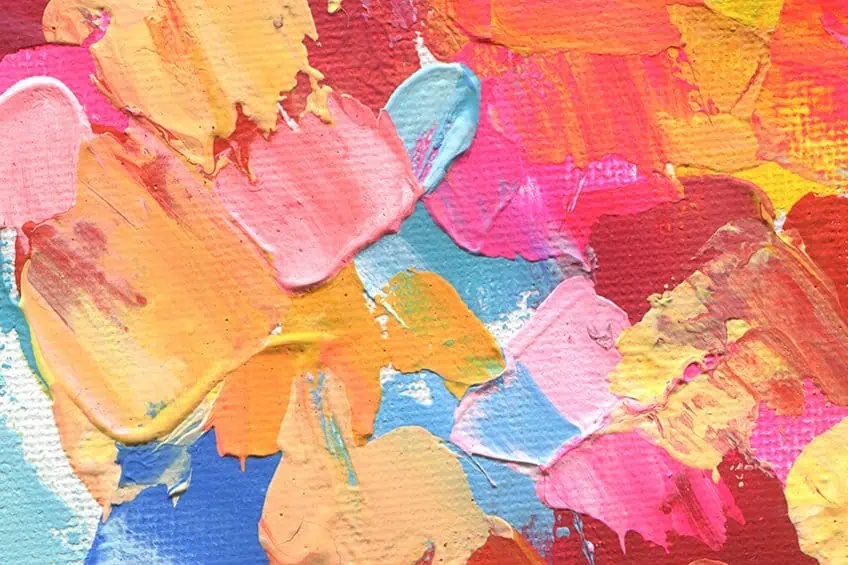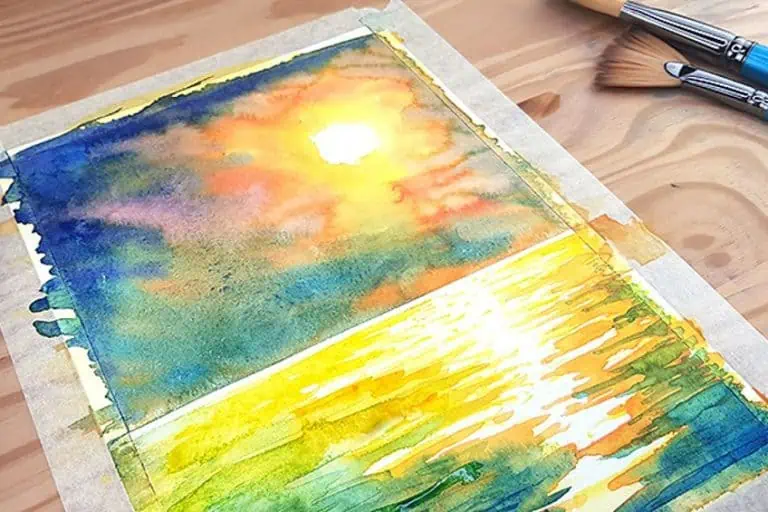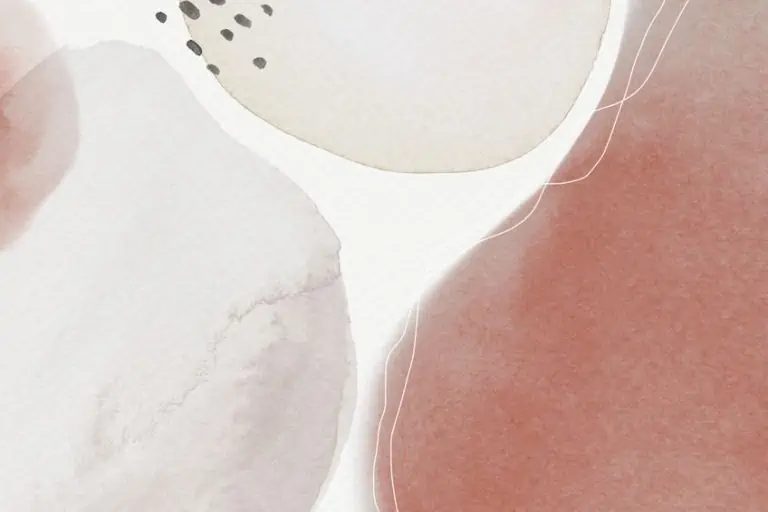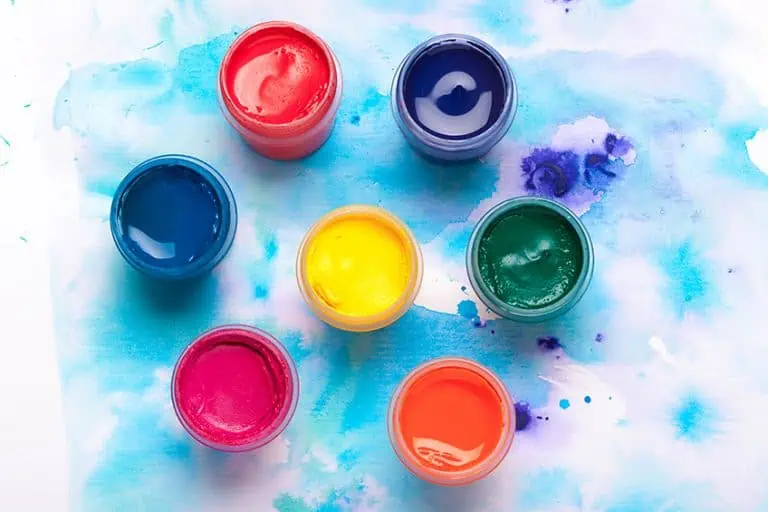Acrylic Painting Ideas – Easy and Fun Painting Ideas For Beginners
This post may contain affiliate links. We may earn a small commission from purchases made through them, at no additional cost to you.
Acrylic paints are widely regarded as one of the best painting mediums for beginners and professionals alike. Acrylic paints are available in a variety of colors and finishes, are non-toxic, very forgiving, generally inexpensive, and are easier to work with when compared to other mediums such as oil or watercolor paints. Acrylic paints are also highly versatile and can be used across a range of surfaces, allowing you to take your creativity beyond the canvas. Whether you are new to acrylic painting or just looking for some motivation, we have compiled a list of easy acrylic painting ideas to inspire your next piece.
Table of Contents
- 1 The Basics of Acrylic Painting
- 2 Beginner-Friendly Acrylic Painting Ideas
- 2.1 Acrylic Painting Ideas for Paper and Cardboard
- 2.2 Acrylic Painting Ideas for Canvas
- 2.3 Acrylic Furniture Painting Ideas
- 2.4 Other Wood and Metal Projects
- 2.5 Acrylic Painting Ideas for Fabric
- 2.6 Acrylic Painting Ideas for Clay
- 2.7 Using Acrylic Paint on Chalkboard
- 2.8 Acrylic Painting on Porcelain
- 2.9 Acrylic Painting on Walls
- 2.10 Acrylic Painting Ideas for Glass
- 2.11 Acrylic Painting on Terracotta Pots
- 2.12 Natural Canvases for Acrylic Painting
- 3 Frequently Asked Questions
The Basics of Acrylic Painting
Before we dive into our list of acrylic painting ideas it is important to understand some of the basics of acrylic painting. The main materials you will need are some paintbrushes in various shapes and sizes, synthetic brushes are usually preferred by beginners as they are cheaper, but you can use many different tools such as sponges, palette knives, or even toothbrushes.
You will also need a palette for mixing colors and, of course, some acrylic paints. Acrylic paints come in different qualities from inexpensive craft-grade paint to professional-grade paints, which are more expensive but tend to be more vibrant, stay true to color once dry, and are resistant to fading over time. Heavy-body or thick acrylic paints are great for beginners.
These paints are easier to work with, require fewer layers for full coverage, and can be watered down to your preferred consistency.
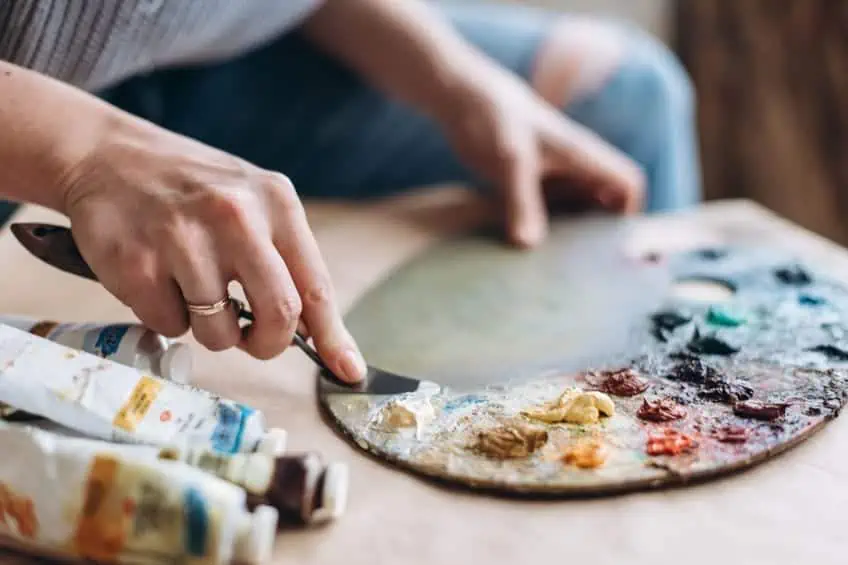
If you wish to make your acrylic painting projects permanent and protect them from dust, ultraviolet light, and chipping, then many surfaces will require a sealant. A clear acrylic sealant or varnish is the easiest and ideal choice depending on the surface. For an easier and even application, a sealant spray is a great choice, especially for beginners. Varnish or sealant comes in many finishes such as matte, glossy, or satin. It is important to experiment to see how they affect your final product.
While some of these projects might require some extra equipment, the following are some of the best acrylic painting ideas for beginners to get you inspired.
Beginner-Friendly Acrylic Painting Ideas
Now that you are armed with your paints and brushes try your hand at these easy acrylic painting ideas that show off the versatility of acrylic paint. If you are just starting out, try sticking to a simple color palette with minimal blending and simple geometric patterns that are not too intricate. If you are still honing your painting skills, stencils are a great tool. Opting for abstract over realistic designs can also take the pressure off of making mistakes, giving you more freedom to experiment.
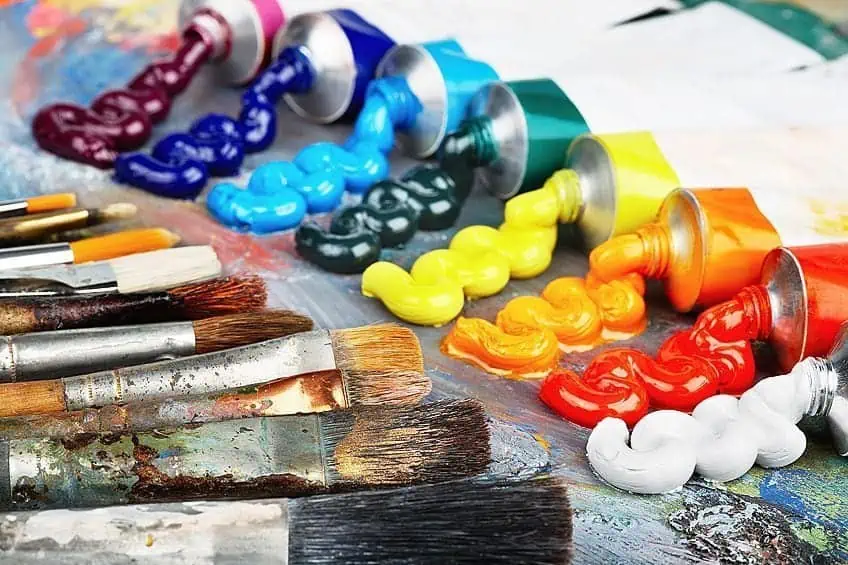
Acrylic Painting Ideas for Paper and Cardboard
The simplest place to start is on paper. Painting on paper is a great option if you are new to acrylic painting and do not want to commit to buying a canvas. Besides being widely available, paper can also be great for sketching or practicing painting ideas for beginners.
Painting on Book Covers
You can use acrylic paint to personalize your notebook or diary covers. These can help spark your creative energy every time you see the cover and get you excited to create. Start by priming your notebook cover with a base coat of black or white acrylic paint to create a blank background for your design. Make sure to put a scrap of paper under the cover so you do not get paint on the rest of the pages in your book. Wait for the paint to dry and then sketch out your design, or trace a stencil, in pencil on the cover.
Use your acrylic paint to fill in your design, working with one color at a time and waiting for each color to dry before starting with the next one.
One of the easiest designs to do, which is also very striking, is color blocking. You do not even need to have drawing skills, all that is required is some painters or masking tape. After applying a base coat of black or white, simply use your tape to create geometric shapes on your notebook cover and then paint each space a different color. Wait until the paint is dry before removing the tape and your design is complete.
Creating Bookmarks
Acrylic paint can also be used to create bookmarks that are not only useful but are great to give as gifts. You can easily create a set of matching bookmarks by dividing up a sheet of paper or poster board, with painter’s tape, into two-by-seven-inch panels. Also, tape down edges to create a clean and professional-looking. border for your bookmarks and ensures that they do not curl up after you begin painting. Ensure that the tape along the edges creates a border that is half the width of the tape that divides the panels. Paint each panel with the same theme, remove the tape once the paint has dried, and then cut along each panel to create the individual bookmarks.

Simple flowers like daisies or sunflowers are great beginner options. You could also try your hand at a simple landscape or scene. One of the easiest scenes is a simple sunset using the three primary colors and black. Paint each color horizontally across your panels in the order of black, blue, red, and yellow, and then blend the bottom of each color into the next. Using a sponge makes it easier to blend the colors versus blending with a brush. Finish off the scene with some simple black palm trees to create a silhouette effect on the sunset background. You can even use a toothbrush to splatter white paint on the black layer to create stars.
Painting on Cardboard
If you have some old delivery boxes lying around, you could decorate them using acrylic paint to create some storage boxes. You could also get creative and paint them into castle towers or racecars to make playtime with your kids extra fun, you can even try recruiting them in the painting. To seal all your designs on cardboard or paper you can use an acrylic sealant spray after they have dried to prevent them from peeling or fading. This way your designs could last up to 10 years, more if you chose a paper that is high quality and acid-free.
Protecting your project from humidity, water, and direct sunlight, by framing them, will also ensure that they last longer.
Acrylic Painting Ideas for Canvas
The most common painting surface for acrylic painting is a canvas. Once again abstract art is a great way to get started if you are still honing your painting skills, in fact almost anything that you have painted on paper can be painted on canvas, using many of the same techniques. Splatter painting is also a great technique for abstract paintings. Simply load up a brush with paint and splatter the canvas with it. You can use a base coat and one color, or multiple colors, the choice is yours.

The trick to impactful abstract paintings is to use different tones, tints, or shades of the same color. Using complementary colors like blue and orange, or analogous colors such as red and violet, are also very impactful. One great benefit to canvas is that you do not need to tape down the edges to prevent the piece from warping as you would with paper.
This is because the canvas is heavier and secured to a frame so not as affected by the water in the paint.
Experiment With Texture and Depth
The heaviness of canvas also allows you to experiment with texture in your acrylic paint creations that paper would not hold up to. Try experimenting with sprinkling grains of sand onto your piece or using gold leaf foil to elevate simple color pallets into statement pieces in your home. Heavy body acrylic paint can be layered with a trowel to add depth to your paintings, a technique that is especially effective in abstract works. You can try mixing different finishes in the same piece such as adding metallic acrylic paint onto a satin base, to create contrast. This method can also be used to match other metals in the room, to easily match your décor, and is especially effective in a sunny room where it catches the light.
When using metallic paint make sure to use an acrylic sealant with a glossy finish so you do not lose the effect.
Try Acrylic Pouring
Canvas is perfect for trying out another acrylic painting idea: acrylic pouring. Acrylic pouring is a method of adding a pouring medium to acrylic paint to give it a flowing consistency, like warm honey or motor oil. You can then pour this paint onto your canvas and move it around until it fills the surface and cascades over the edge. You could use water to thin your acrylic paint if you are just starting out, but the colors often lose some vibrancy and can even crack when dry.

Pouring medium also ensures that the paint does not dry out too quickly, which gives you more time to maneuver the paint especially if you are just starting out. Some artists also add silicone to their paint mix as this creates pockets that pop when heat is applied to the paint, creating a beautiful effect. An acrylic pour can form the background to a simple line art design or can create a beautiful, almost geode-like centerpiece.
Beginner Acrylic Pouring Techniques
Acrylic pouring can seem intimidating but there are a variety of techniques that are beginner-friendly. Acrylic pouring is also great because, like many other projects on this list, you do not need any drawing or painting experience to create something beautiful. The finished product also looks very complex even though it is very simple and quick to make. One poured acrylic painting can even take less than 30 minutes to complete.
One technique is to use a funnel. Stand a funnel on top of your canvas so that paint cannot run out of the bottom.
Fill up the funnel by alternating paint colors so that they form layers on top of one another. When the funnel is full, lift it carefully to allow the paint to flow out slowly while moving it back and forth, until all the paint has run out. Slowly tilt your canvas in all directions to spread the paint around, until it flows over the edge. If you have added silicone to your paint, you can now use a butane torch to pop the cells.
The Dutch pour is another technique where you layer your paints in the center of your canvas and use air to manipulate the paint. You do not need any special tools to do this, and many use a hair dryer or even your breath to move the paint around. When your acrylic pour is done be sure to place it in a safe place, so it dries completely, without being disturbed.

To ensure that all your canvas acrylic paintings are protected, use a few thin coats of an acrylic sealant spray after the paint has dried. Acrylic paintings on canvas last longer than their oil-based counterparts and some experts have even estimated that, if stored correctly, they will last for a few centuries. To store properly, keep your paintings away from areas where they will be exposed to heat, direct sunlight, or high humidity.
You should also use a primed but not varnished canvas to limit the chances of your painting peeling.
Acrylic Furniture Painting Ideas
Acrylic paint does not need to be confined to the art studio, try out these cool acrylic painting ideas for your old or outdated furniture. Acrylic paint can be used on both wooden and metal furniture, and with the correct preparation and sealant, last for many years without fading.

Painting Metal Furniture
Metal furniture can also be a great candidate for your acrylic makeovers. Metal furniture and accents tend to become tarnished or discolored over time, and acrylic paint can breathe new life into them. An old rusty bench, door handles, lamps, or even your bed frame can all be painted with acrylic paint. Acrylic paint is ideal for indoor surfaces and requires you to prime the surface first.
This allows the paint to adhere to the surface better and protects the metal from rusting.
To start, remove any existing paint or rust on the furniture you wish to paint, as well as any fixtures you do not. Sand down the surface of the metal until it is smooth and then wipe it down with a damp cloth. You may then prime the metal and allow it to dry completely before you start painting. Do not forget to seal it all up, with a varnisher or acrylic sealant, to ensure your new paint job lasts.
Painting Wooden Furniture
Wood is an excellent surface for acrylic paint. Cleaning and priming the wood’s surface will ensure that your acrylic paint does not shrink or crack after it has dried. Wooden furniture is often already varnished or sealed so you will need to sand off the top layer with fine-grit sandpaper to allow your acrylic paint to adhere properly. To clean the wood, use a damp, soapy cloth to wipe the surface. Be careful to not use too much water as you will have to wait until it dries completely before painting and you risk warping your wood.
You can prime your wood with gesso or a water-based wood primer to make your painting last longer, especially if you are painting a surface that is outdoors or touched a lot. Primer will also prevent any impurities in your wood from discoloring your paint. After you are finished painting, leave it to dry for two to three days, then seal the paint with a varnish or furniture wax to protect it.
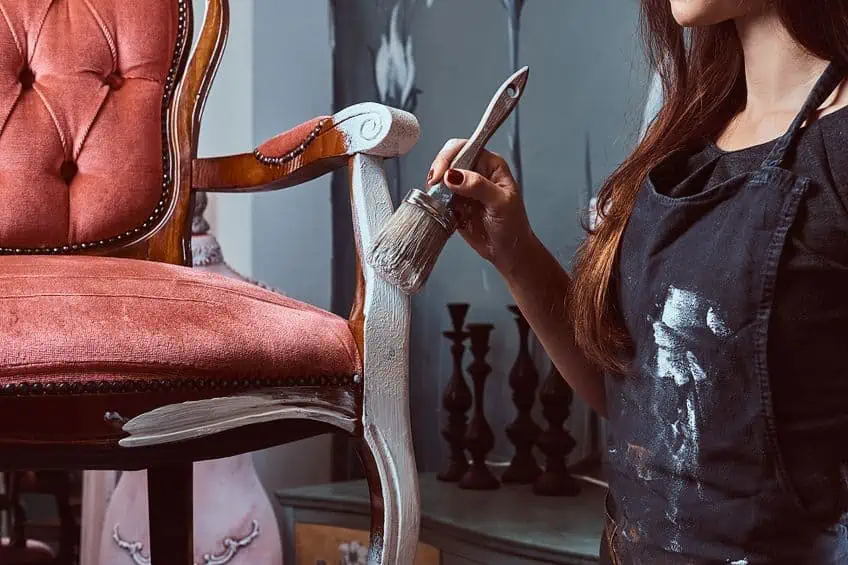
Refurbish or restyle wooden furniture in your home effortlessly with intricate designs, using stencils or stamps, to give your furniture that bohemian feel. Geometric patterns are easy and give an art deco atmosphere to any room. If you want to add a personal touch to your furniture, but remain flexible with your style, then painting the inside and sides of drawers in dressers and side tables is another great idea.
You can have the freedom to be as bold as you would like as the face of the drawer will hide it all when it is closed.
Other Wood and Metal Projects
You do not need to confine your acrylic painting ideas to just furniture. Have you ever wanted one of those cute wooden signs but could never find one exactly for you in-store? With acrylic paint, you can create your very own. You can even paint wood slices for coasters or key rings. These are great to give to friends as gifts or even to sell. Wood is also a great surface to try out acrylic pouring.
Metal jewelry or musical instruments can also be painted to express your creativity.
One great acrylic painting idea is painting a metal flask with your favorite coffee pun or even a reminder to keep you motivated to drink water. Do not forget to seal your design with a waterproof sealant, and hand-wash your flask to ensure your design lasts longer. Remember that acrylic paint and sealant may be non-toxic, but they are not food safe. Therefore, it is a good idea to leave at least a half-inch from the rim unpainted and unsealed. If your project is properly prepared and sealed, acrylic paint will usually last for five to 10 years on wood and metal surfaces.
Acrylic Painting Ideas for Fabric
Fabric is another great place to try out your painting ideas. All different blends of fabric can be painted on with acrylic paint without much preparation. Simply wash the fabric as normal to remove any oils or dirt and dry completely before painting. Fabric acrylic paint does not crack on drying like conventional acrylic paints, and it will stay on permanently but may fade over a few years and need to be touched up.

Fabric can be used in a variety of acrylic painting ideas for beginners. Acrylic painting on fabric provides a way to change the look of your décor and furniture at a fraction of the cost and without the hassle of going from shop to shop. Throw pillows, placemats, and dining chair cushions are a great way to add color or patterns to your space. Why not use acrylic paint to change inexpensive, plain pillowcases into something that is perfect for your space.
Acrylic Painting on Clothes
Painting t-shirts is a great activity for the family or a way to create something unique to mark an occasion. You can even use glue to sketch an image onto your t-shirt. Once it has dried, paint over it with multiple colors, then peel off the glue to reveal your design. You can also paint your shoes with acrylic paint. Pencil your design onto clean, dry shoes and check to make sure it looks good from all angles before filling in your design with paint.
Fabric acrylic paint is essential because normal acrylic paint will crack once dry with the everyday movement of the shoe.
If you are painting leather shoes, then use acrylic paints that are specially made to adhere to leather, otherwise sanding down the surface of the shoe may help fabric acrylic paint adhere to it. Wait a few days before wearing your shoes to be sure that they are completely dry then spray on an acrylic sealer to protect against water damage. Use a damp cloth to gently clean shoes if they get dirty.

The best way to set the acrylic paint in fabric so that it does not wash out or fade is to heat-set it. Allow your painted piece to dry undisturbed for at least 24 hours to ensure that it is completely dry. Layout the fabric with the design flat and then place a piece of parchment paper over it. Heat your iron to medium-high heat and then run the iron back and forth over the areas with the acrylic paint for three to five minutes to set the paint. Allow it to cool completely before removing the parchment paper.
Be sure to wash t-shirts and throw pillow covers inside-out, if possible, to further protect them.
Acrylic Painting Ideas for Clay
Acrylic paint is one of the best paints for painting clay sculptures. Painting clay can be just as fun as molding the clay and acrylic paint can be used to add color, details, and depth to the otherwise blank statues, which really brings them to life. Air-dry clay is great for beginners as you do not need a kiln, unlike polymer clay, which must be baked.
Air-dry clay comes in different neutral colors such as grays and terracotta, but white clay is the best option if you are planning to paint with acrylic, as this will not change the look of your colors.
Ensure that your clay has dried completely before you begin painting your piece, this usually takes one to three days. Be careful to not add too much water to the paint as this will soften the clay, which may cause the clay to crack when it dries. You can use gesso to prime the clay to help protect against this. It is best to seal your piece afterward, otherwise, the paint will peel or wash off. Acrylic sealer is the best way to seal your statues and a spray works best when your piece has a lot of edges.

If you are disappointed by the limited colors of air-dry clay, you can also use acrylic paint to color it. Before you sculpt your clay, knead a small amount of acrylic paint through the clay until you create your desired color. Be aware that the clay may take longer to dry so use as little paint as possible.
Using Acrylic Paint on Chalkboard
Many cool acrylic painting ideas show off your creativity while also saving you money. Acrylic paint can be used on small chalkboards for weddings, birthdays, and other special events. These are excellent for displaying table numbers inside an elegant border that matches your theme. You could even create a board for guests to write messages, which can later be sealed for lasting memories.
You can either paint directly onto a clean and dry chalkboard or, if you are even more DIY-inclined, you could paint a surface with chalkboard paint to create your own custom chalkboard.
Chalkboard paint can be used on various surfaces such as wood and metal, so it is easy to create one that fits your needs. Be sure to wait until the chalkboard paint has dried completely before starting with your acrylic designs and do not forget to seal your acrylic paint designs so that they do not come off. Attach small disc magnets to the back of a chalkboard using hot glue and use acrylic paint to add drawings of fruits and vegetables. Top it off with a border and heading and seal it once dry, to create a magnetic shopping list board that you can easily stick onto your fridge door.
Acrylic Painting on Porcelain
Another surface on which acrylic paints can be used is porcelain. Why not try acrylic painting and stamping to refurbish or update your tiles. Painted tiles that get wet a lot or are in high-traffic areas, such as in bathrooms or hallways, will not last long. However, your kitchen backsplash makes a great canvas for acrylic painting. For the most longevity be sure to use acrylic paint specifically for porcelain and ceramics.
Porcelain tiles also make a great surface for acrylic pouring.

Ceramics do not just end at tiles. Plain mugs and plates can also be painted or dipped with acrylic paint to create unique pieces. Be sure to cure and seal them to guarantee their longevity, and hand wash them to make them last even longer. It is important to remember that acrylic paints and sealers are non-toxic but are not considered food safe. You should, therefore, only use them on surfaces that are not in direct contact with food like the underside of the plate. Avoid painting the top half-inch of the rim of mugs and teacups as well.
Acrylic Painting on Walls
Another great idea is to use acrylic paints on your walls. Acrylic paints can be used to paint kids’ bedrooms or playroom walls with fun scenes and characters. However, acrylic painting walls is not just for kids. Because acrylic paint comes in a broader array of colors than otherwise might be available, it is better than regular wall paint for creating a beautiful art mural or a detailed feature wall.
Acrylic paint even comes in variants suitable for outdoor use so it can withstand the weather.
If you use a sealant and protect your painting from excess moisture, your paint can last around seven years before needing to be touched up. It is important to make sure that any underlying wall paint is not oil-based paint as the water-based acrylic paint will not last long and may end up peeling off both layers. If you are painting a bare wall, add a base coat of paint to make painting easier and colors more impactful.
Acrylic Painting Ideas for Glass
Ceramics are not the only crockery that can be painted with acrylic paint. Glass cups, plates, or even fruit bowls can also be painted with acrylic paint. What is great about glass painting is that you are able to see your designs even if they are painted on the underside of your glassware. Just as with ceramic crockery, only paint surfaces that will not be in direct contact with food. You can mix acrylic paint with dish soap to create temporary glass paint, which makes a great family activity that can be washed off at the end of the day.
Acrylic paint can also be made permanent on glass by sealing it with an acrylic sealant or varnish, otherwise, it will chip off after a few years.

If you do not have any wall space for canvas art, then why not paint your art onto your glass windows using acrylic paint. Acrylic paint is also great for holiday decorating as it can be scraped off at the end of the season. Glass mason jars are great to try out your painting ideas.
You can paint labels onto the jars for easy pantry organization.
You can also paint scenery or landscapes that wrap around the jar. To create an easy nightlight, try adding a small bundle of battery-powered fairy lights into a painted jar. Secure the battery pack to the lid for ease of access when you have to change them.
Acrylic Painting on Terracotta Pots
Terracotta pots are another material that can be painted with acrylic. They can be used to add your own personality or aesthetic to the simple orange pots. Clean your pots with water and a brush to get rid of old soil or dust and create a smooth surface for your acrylic paint. Ensure the pots are completely dry before you begin painting and allow them to dry between coats of paint. If you plan on planting leafy plants, a simple face painted on their pot can give the effect of green hair growing out. Color block waves of warm orange, yellow, and coral colors to mimic a desert color palette for succulent plants. A simple geometric leaf pattern is also good if you are looking for a more modern look for your terracotta pots, and many stencils or stamps are available.
You can also use acrylic paint to label herb pots if they are growing indoors. We especially like solid-colored pots with cute wordplay such as “here for a good thyme” or “rooting for you”.
As terracotta is porous the water that you water your plants with will seep through and damage any designs painted on the outside. If you want to prevent this and ensure that your design lasts for many years, you should seal the inside and outside of the pot with a sealant before painting them. After painting your pot, you should then seal it again to protect your paint from the elements. Be sure to use a sealant that is ultra-violet resistant as your pots will likely be spending a lot of time in the sun. You should also use a sealant that is designed for clay pots as these are often weatherproof. If you are painting pots meant for succulents, use a water-based paint primer instead. Although your paint may not last as long, your pot will be more breathable, which is ideal for succulent roots.
Natural Canvases for Acrylic Painting
Nature provides lots of inspiration for acrylic painting. While already beautiful, seashells can be painted to add interest, or you could layer a few painted shells onto a canvas for an eye-catching piece. Acrylic paints do not get absorbed into the shell’s surface like watercolor paints would, so you can create layered designs without losing the unique texture of the shell.
Painting a beach scene or landscape on your seashells is a great idea, or try turning them into fish by gluing a googly eye to one side and smaller pieces of shells to the other to create fins.
Smooth shells without any cracks or chips are best to use for acrylic painting. Make sure they are clean. You can use an old toothbrush and warm water to clean them. If you want to paint the whole seashell, then prime it with a base coat of paint and allow it to dry before painting the rest of your design.

Rocks can also be painted to create doorstops or paperweights. You can paint them as ladybugs or toadstools and hide them amongst your plants to add some whimsy to your garden, or even use them to label your herbs and produce. Be sure to choose acrylic paint that is suitable for the outdoors if you want them to last.
Sticks are also a great item to paint and can provide you with inexpensive home décor for a variety of aesthetics. Paint sticks white with a fan brush to give it a birched wood look for rustic décor, and if they are long enough you could use them to make a partition. For a more modern look that is great for entryways and side tables, paint sticks a solid metallic color such as gold or silver, and set them in your favorite vase.
Acrylic paints are some of the easiest and most versatile paints to use. As you have read, they can be used on a variety of materials and require very few other tools to create complex-looking pieces on a budget. Maybe you could try combining the different techniques and materials we discussed to produce something entirely unique. We hope this list of painting ideas for beginners and professionals alike, has inspired you to start creating with acrylic paint.
View our Easy Acrylic Painting Ideas web story here.
Frequently Asked Questions
What Things Can You Paint With Acrylic Paint?
Acrylic paint is a very versatile medium and allows you to paint almost every surface successfully. Some surfaces such as plastic, glass, and varnished wood may need to be prepared before you paint for the best results.
Is Acrylic Painting Easy?
Acrylic painting is great for beginners as paints are relatively inexpensive and easy to work with when compared to other mediums such as watercolors and oil paints. They are also available in many different colors and finishes.
What Do I Need for Acrylic Painting?
Some essential supplies for acrylic painting besides the paint itself are paint brushes or sponges of various shapes and sizes, a palette for mixing paint colors, a painting surface such as canvas or paper, rags to clean brushes and paint, some water for thinning paint and cleaning brushes, and a sealant for your finished project.
How Long Does Acrylic Paint Last?
The material that you paint on, how well the surface has been prepared, and how exposed it is to the elements all determine how long the paint will last. Acrylic paint on canvas can last for a few decades whilst acrylic paint on glass may only last a few years. The best way to ensure your work lasts is to cover it with a layer of acrylic sealant or varnish.
Megan is a writer and researcher who graduated from the University of Cape Town with a degree in Social Sciences, specializing in Psychology and Environmental Science. Her passion for knowledge and leaving a positive impact has fueled her current work in conscious and sustainable growth in Southern Africa. Megan’s love of nature has also led her to train as an animal behaviorist. She works part-time training and rehabilitating dogs. Megan is interested in the physical and psychological effects of colors in our environment on our mood and well-being. In addition, she is concerned with how art and creativity have been an integral part of human society. Megan van Schoor has been writing blog posts on the topics of painting, drawing, and color theory for acrylgiessen since 2021.
Learn more about Megan van Schoor and about us.
